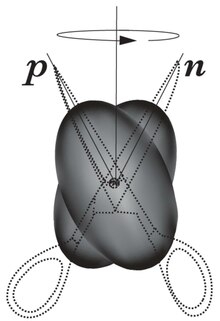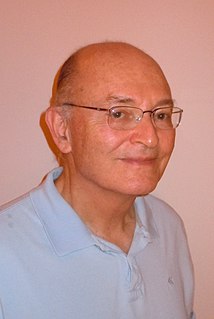Related Research Articles

X-ray absorption fine structure (XAFS) is a specific structure observed in X-ray absorption spectroscopy (XAS). By analyzing the XAFS, information can be acquired on the local structure and on the unoccupied local electronic states.

Extended X-ray absorption fine structure (EXAFS), along with X-ray absorption near edge structure (XANES), is a subset of X-ray absorption spectroscopy (XAS). Like other absorption spectroscopies, XAS techniques follow Beer's law. The X-ray absorption coefficient of a material as a function of energy is obtained using X-rays of a narrow energy resolution are directed at a sample and the incident and transmitted x-ray intensity is recorded as the incident x-ray energy is incremented.
octopus is a software package for performing Kohn–Sham density functional theory (DFT) and time-dependent density functional theory (TDDFT) calculations.
Jozef T. Devreese is a Belgian scientist, with a long career in condensed matter physics. He is Professor Emeritus of Theoretical Physics at the University of Antwerp.

Electron beam ion trap (EBIT) is an electromagnetic bottle that produces and confines highly charged ions. An EBIT uses an electron beam focused with a powerful magnetic field to ionize atoms to high charge states by successive electron impact.

David Matthew Ceperley is a theoretical physicist in the physics department at the University of Illinois Urbana-Champaign or UIUC. He is a world expert in the area of Quantum Monte Carlo computations, a method of calculation that is generally recognised to provide accurate quantitative results for many-body problems described by quantum mechanics.
Hot spots in subatomic physics are regions of high energy density or temperature in hadronic or nuclear matter.
Fritz Peter Schäfer was a German physicist, born in Hersfeld, Hesse-Nassau. He is the co-inventor of the organic dye laser. His book, Dye Lasers, is considered a classic in the field of tunable lasers. In this book the chapter written by Schäfer gives an ample and insightful exposition on organic laser dye molecules in addition to a description on the physics of telescopic, and multiple-prism, tunable narrow-linewidth laser oscillators.
Spin-polarized electron energy loss spectroscopy or SPEELS is a technique that is mainly used to measure the dispersion relation of the collective excitations, over the whole Brillouin zone.

Resonant inelastic X-ray scattering (RIXS) is an X-ray spectroscopy technique used to investigate the electronic structure of molecules and materials.
Yambo is a computer software package for studying many-body theory aspects of solids and molecule systems. It calculates the excited state properties of physical systems from first principles, e.g., from quantum mechanics law without the use of empirical data. It is an open-source software released under the GNU General Public License (GPL). However the main development repository is private and only a subset of the features available in the private repository are cloned into the public repository and thus distributed.
Stephan W. Koch is a German theoretical physicist. He is professor at the University of Marburg and works on condensed-matter theory, many-body effects, and laser theory. He is best known for his seminal contributions to the optical and electronic properties of semiconductors, semiconductor quantum optics, and semiconductor laser designs. Major portion of his research work has focused on the quantum physics and application potential of semiconductor nanostructures. Besides gaining fundamental insights to the many-body quantum theory, his work has provided new possibilities to develop, e.g., laser technology, based on accurate computer simulations. His objective has been to self-consistently include all relevant many-body effects in order to eliminate phenomenological approximations that compromise predictability of effects and quantum-device designs.
Searches for Lorentz violation involving photons provide one possible test of relativity. Examples range from modern versions of the classic Michelson–Morley experiment that utilize highly stable electromagnetic resonant cavities to searches for tiny deviations from c in the speed of light emitted by distant astrophysical sources. Due to the extreme distances involved, astrophysical studies have achieved sensitivities on the order of parts in 1038.

Scissors Modes are collective excitations in which two particle systems move with respect to each other conserving their shape. For the first time they were predicted to occur in deformed atomic nuclei by N. LoIudice and F. Palumbo, who used a semiclassical Two Rotor Model, whose solution required a realization of the O(4) algebra that was not known in mathematics. In this model protons and neutrons were assumed to form two interacting rotors to be identified with the blades of scissors. Their relative motion (Fig.1) generates a magnetic dipole moment whose coupling with the electromagnetic field provides the signature of the mode.

Edward Ott is an American physicist most noted for his contributions to the development of chaos theory.
Photo-reflectance is an optical technique for investigating the material and electronic properties of thin films. Photo-reflectance measures the change in reflectivity of a sample in response to the application of an amplitude modulated light beam. In general, a photo-reflectometer consists of an intensity modulated "pump" light beam used to modulate the reflectivity of the sample, a second "probe" light beam used to measure the reflectance of the sample, an optical system for directing the pump and probe beams to the sample, and for directing the reflected probe light onto a photodetector, and a signal processor to record the differential reflectance. The pump light is typically modulated at a known frequency so that a lock-in amplifier may be used to suppress unwanted noise, resulting in the ability to detect reflectance changes at the ppm level.

Louis Franklin DiMauro is an American atomic physicist, the Edward and Sylvia Hagenlocker Professor In the Department of Physics at The Ohio State University, Columbus, Ohio, USA. His interests are atomic, molecular and optical physics. He has been elected a Fellow of the American Association for the Advancement of Science, American Physical Society and Optical Society.
Bose–Einstein condensation of polaritons is a growing field in semiconductor optics research, which exhibits spontaneous coherence similar to a laser, but through a different mechanism. A continuous transition from polariton condensation to lasing can be made similar to that of the crossover from a Bose–Einstein condensate to a BCS state in the context of Fermi gases. Polariton condensation is sometimes called “lasing without inversion”.
In accelerator physics, a kinematically complete experiment is an experiment in which all kinematic parameters of all collision products are determined. If the final state of the collision involves n particles 3n momentum components need to be determined. However, these components are linked to each other by momentum conservation in each direction and energy conservation so that only 3n-4 components are linearly independent. Therefore, the measurement of 3n-4 momentum components constitutes a kinematically complete experiment.

Sydney Meshkov was a Theoretical Physicist who worked in gravitational wave, atomic, nuclear and particle physics.
References
- ↑ http://www.dp-code.org
- ↑ Runge, Erich; Gross, E. K. U. (19 March 1984). "Density-Functional Theory for Time-Dependent Systems". Physical Review Letters. American Physical Society (APS). 52 (12): 997–1000. Bibcode:1984PhRvL..52..997R. doi:10.1103/physrevlett.52.997. ISSN 0031-9007.
- ↑ Gross, E. K. U.; Kohn, Walter (23 December 1985). "Local density-functional theory of frequency-dependent linear response". Physical Review Letters. American Physical Society (APS). 55 (26): 2850–2852. Bibcode:1985PhRvL..55.2850G. doi:10.1103/physrevlett.55.2850. ISSN 0031-9007. PMID 10032255.